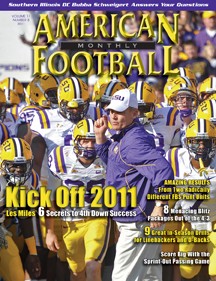Article CategoriesAFM Magazine
|
Overcompensate in the Coop - Drills to Improve Your Defenseby: Bob LancasterDefensive Coordinator Catawba College © More from this issue I have come to realize that it doesn’t matter what level of football you coach - fundamentals are the most important aspect. At Catawba College, our defensive philosophy is to keep things simple so our athletes can perform at the highest level. Fundamentals are of utmost importance. A phrase that is used many times, like a broken record, is “lower your pad level!” But what does this mean and how can I get this accomplished without repeating myself over and over? I will explain some drills that we perform daily to overcompensate pad level and flexion points. The “Coop” has become an integral part of our fundamental instruction. All of these drills can be executed in or out of the coop. The “Coop” forces all 3 power points to be in correct position. The 3 power points are: 1. &....The full article can only be seen by subscribers.
|
|
|||||||
| HOME |
MAGAZINE |
SUBSCRIBE | ONLINE COLUMNISTS | COACHING VIDEOS |
Copyright 2025, AmericanFootballMonthly.com
All Rights Reserved





